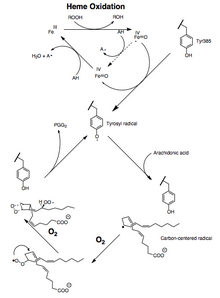In organic chemistry, pentadiene is any hydrocarbon with an open chain of five carbons, connected by two single bonds and two double bonds. All those compounds have the same molecular formula C5H8. The inventory of pentadienes include:
- 1,2-pentadiene, or ethyl allene, H2C=C=CH−CH2−CH3.[1]
- 1,3-pentadiene, H2C=CH−CH=CH−CH3 with two isomers:[2][3]
- cis-1,3-pentadiene.
- trans-1,3-pentadiene, also known as piperylene.
- 1,4-pentadiene, H2C=CH−CH2−CH=CH2.[4]
- 2,3-pentadiene, H3C−CH=C=CH−CH3, with two enantiomers (R and S).[5]
Well known derivatives containing pentadiene groups include hexadienes, cyclopentadiene, and especially three fatty acids linoleic acid, α-linolenic acid, and arachidonic acid as well as their triglycerides (fats).
Preparation and basic reactions
1,4-Pentadiene can be prepared from 1,5-pentadiol via the diacetate.[6]
1,3-Pentadiene, like 1,3-butadiene, undergoes a variety of cycloaddition reactions. For example, it forms a sulfolene upon treatment with sulfur dioxide.[7]
Pentadienyl
Pentadienyl refers to the organic radical, anion, or cation with the formula [CH2(CH)3CH2]z, where z = 0, −1, +1, respectively.
Biochemistry
Methylene-interrupted polyenes are 1,4-pentadiene groups found in polyunsaturated fatty acids linoleic acid, α-linolenic acid, and arachidonic acid. These pentadiene derivatives are susceptible to lipid peroxidation, far moreso than monounsaturated or saturated fatty acids. The basis for this reactivity is the weakness of doubly allylic C-H bonds, leading to pentadienyl radicals. A range of reactions with oxygen occur. Products include fatty acid hydroperoxides, epoxy-hydroxy polyunsaturated fatty acids, jasmonates, divinylether fatty acids, and leaf aldehydes. Some of these derivatives are signallng molecules, some are used in plant defense (antifeedants), some are precursors to other metabolites that are used by the plant.[8]
Cyclooxygenases ("COX") are enzymes that generate prostanoids, including thromboxane and prostaglandins such as prostacyclin. Aspirin and ibuprofen exert their effects through inhibition of COX.

Drying and rancidification

Simplified chemical reactions associated with the formation of a hydroperoxide from a typical polyunsaturated fatty acid. In the second step, the hydroperoxide combines with another unsaturated side chain to generate a crosslink.[9]
Fats containing 1,4-pentadiene groups are drying oils, i.e. film-forming liquids suitable as paints. One practical consequence is that polyunsaturated fatty acids have poor shelf life owing to their tendency toward autoxidation, leading, in the case of edibles, to rancidification. Metals accelerate the degradation.
Organometallic chemistry
In organometallic chemistry, the pentadienyl anion is a ligand, the acyclic analogue of the more-common cyclopentadienyl anion. The pentadienyl anion is generated by deprotonation of pentadiene. A number of complexes are known, including bis(pentadienyl) iron, Fe(C5H7)2, the "open" analog of ferrocene. Only few pentadienyl complexes feature simple C5H7 ligands. More common is the dimethyl derivative 2,4-Me2C5H5. Additionally, many pentadienyl ligands are cyclic, being derived from the addition of hydride to η6-arene complexes or hydride abstraction from cyclohexadiene complexes.[10][11]
The first pentadienyl complex to be reported was derived from protonolysis of a complex of pentadienol:[12]
- Fe(C5H7OH)(CO)3 + H+ → [Fe(C5H7)(CO)3]+ + H2O
Treatment of this cation with sodium borohydride gives the pentadiene complex:
- [Fe(C5H7)(CO)3]+ + H− → Fe(C5H8)(CO)3
Further reading
- Juergen Herzler , Jeffrey A. Manion, and Wing Tsang (2001): "1,2‐Pentadiene decomposition". International Journal of Chemical Kinetics, volume 33, issue 11, pages 755-767. doi:10.1002/kin.1072
